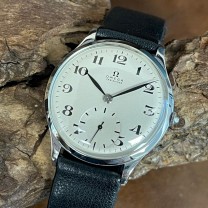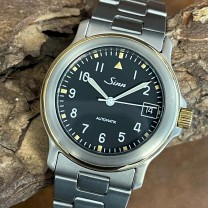Watch Encyclopedia
In our watch encyclopedia you can find the most important terms relating to watches
Automatic winding movement
With regular wear the rotor is kept in motion. The rotor spins around the inside of the watch and thus automatically winds the watch.
Blue hands, blue screws:
Metal parts that are heated to a temperature of 290 degree and turn blue due tot he extreme heat.
Domed glass:
Domed glass above the dial or at the bottom of the case.
Cabochon:
Decorative stone or gem with a rounded finish that is only used as decoration, e.g. on the crown of a watch.
Chronograph:
Greek for „time slider“. A watch with an additional stopwatch function to measure seconds, minutes or hours.
Perpetual calender:
A watch showing the date, day, month and moonphase. This is possible due to a complicated mechanism that will correctly adjust for short and long months and leapyears, according to the Gregorian calendar.
Power reserve:
The number of hours the movement works before it runs down.
Hallmark of Geneva:
Quality certificate in the form of the Geneva city coat of arms. This stands for highly qualified, mechanical watches that have been assembled and regulated in the canton of Geneva.
Genevan stripes:
Decorative stripes on parts of the movement, mostly plates and bridges. This makes only sense for watches that are partly skeletonized or that have a glass base through which you can see the movement.
Guilloche:
Decoration with fine, entwined patterns on the dial or case.
GMT:
Greenwich-Mean-Time, the standard universal time.
Manual winding movement:
Historically the first method, which winds the mainspring by manually winding the watch with a key or crown. Even today watches with manual winding movements are still quite popular, considering that there are more modern automatic winding movements and battery-driven movements on the market.
Helium escape valve:
Important feature in professional diver’s watches. The air in diving bells and diving stations deep underwater is enriched with helium, in order to make breathing easier. The helium penetrates the sealing of the watch and can cause excess pressure. This effect is balanced out by the helium release valve.
Perpetual calender:
A complication that adjusts the calendar for months of varying lengths as well as leap years.
Caliber:
Name of the movement. Usually consists of letters and numbers that indicate the origin, series and size of the movement. This is especially important in case spare parts are needed.
Moon-phase (lumination) indicator:
Shows the current phase of the moon, as seen from Earth. The cycle from new moon to half moon, full moon and back to new moon is 29,5 days.
Quartz movement:
An electrical movement in which the oscillation of a quartz crystal keeps the time. The power is usually generated by a tiny battery, or even by a system of photo cells that turn light into power. Modern quartz watches usually do not deviate more than one minute per year.
Rhodium plating:
Metal surfaces are galvanically finished, in order to make them harder and shinier.
Sapphire glass:
The toughest among all glass types. It is made from synthetic sapphire and thus extremely scratch-proof. Due to its physical properties, it can only be treated with diamonds or diamond powder.
Second stop:
With this mechanism you can stop the second hand, while the movement is still operating. This way you can set the time to the precise second.
Stones:
They serve as a nearly wear-free bearing for the axes of important movable parts in the watch. In the past, real gemstones were used for this. Nowadays, synthetic rubies and sapphires are usually in use.
Shock protection:
Elastically mounted bearing of the balance wheel. It protects the pivots from breaking at hard pushes.
Tourbillon:
Very complicated system which neutralizes the influence of gravity. From a mechanical and aesthetical point of view it is so fascinating that it is often displayed through a window in the dial.
Balance wheel:
Round metal ring which, rotating back and forth, determines the precision of the movement. For this, the balance wheel transmits the energy of the balance spring through exactly calculated impacts to the movement.






